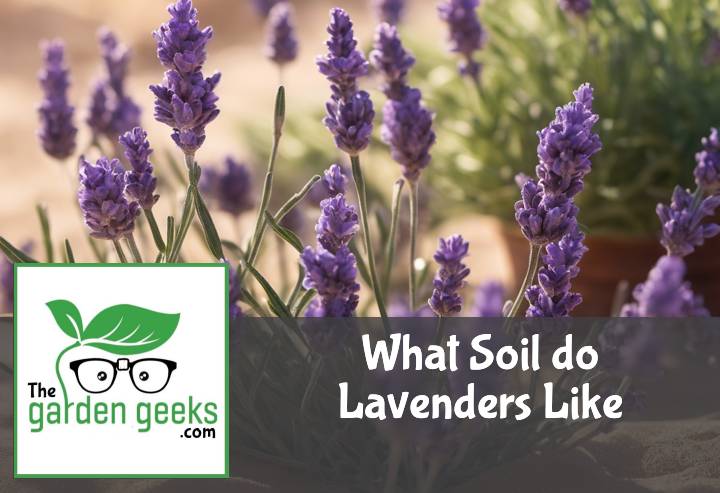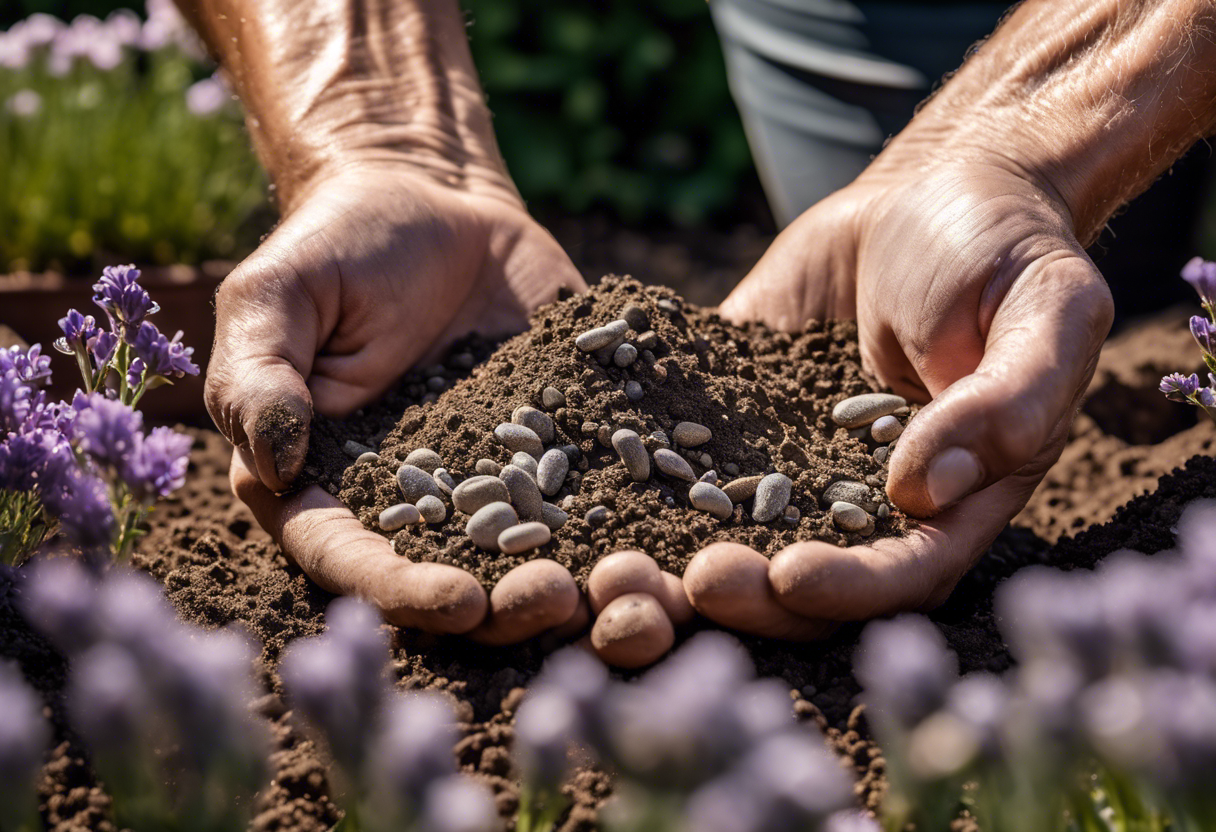Ever found yourself in the garden center, staring at a lavender plant and wondering, What Soil do Lavenders Like? Well, you’re not alone! Many of us green-thumbed folks have been there, scratching our heads over this seemingly simple question.
But don’t worry! You’ve stumbled upon the right place. This blog post is dedicated to unraveling the mystery of lavender-friendly soils. So grab your gardening gloves and let’s dig into this together. “Keep reading about What Soil do Lavenders Like?”
Key Takeaways
- Lavenders prefer well-drained, alkaline soil with a pH between 6.7 and 7.3.
- They thrive in sandy or gravelly soils, which provide good drainage.
- Organic matter like compost can improve soil conditions for lavenders.
- Overly fertile or clay-based soils are not suitable as they retain too much water.
- Lavenders need full sun exposure and good air circulation to grow properly.
What is Lavender?
Lavender, oh sweet lavender! It’s not just a pretty face in the garden. This lavender plant is known for its stunning purple flowers and intoxicating scent. But did you know it has many uses too? From aromatherapy to culinary delights, lavender uses are as diverse as its vibrant blooms.
Now, let’s talk about lavender characteristics. It’s a hardy little thing, able to withstand hot summers and chilly winters. And the types of lavender? Well, there’s quite a variety!
Origin and Types of Lavender
Lavender hails from the Mediterranean region – think sunny skies and rocky soils. That’s where our friend got its love for well-drained soil and lots of sunshine.
There are several different types of lavender, each with their own unique needs. The most common ones are English Lavender (Lavandula angustifolia) and French Lavender (Lavandula stoechas).
English Lavender is your classic variety, adored for its strong scent and deep purple flowers. On the other hand, French Lavender sports a lighter fragrance with distinctly shaped blooms that look like butterflies atop slender stalks.
Importance of Soil for Lavender Growth
So why does soil matter so much when it comes to growing lavender? Well, the right soil for lavender growth can make or break your plant’s health.
You see, lavenders aren’t too fussy about soil type as long as it’s well-draining. They don’t like wet feet – soggy soil can lead to root rot which is a big no-no!
The importance of soil in gardening cannot be overstated. It provides nutrients, supports roots, and regulates water access. For healthy lavender growth, aim for slightly alkaline soil with good drainage.
Remember folks – when it comes to yielding healthy lavenders, the right soil is key! So, what soil do lavenders like? Let’s find out in the next section.
What are the General Soil Requirements for Lavenders?
When it comes to lavender soil needs, there’s a bit more to it than just plopping your plant in any old dirt. You see, lavenders are a bit picky when it comes to their home. They need the right pH level, good drainage, and certain nutrients.
Soil pH Level
Now, let’s talk about soil pH for lavenders. These plants prefer slightly alkaline soil with a pH between 6.7 and 7.3. Why? Well, this range helps them absorb nutrients better.
But don’t worry if your garden isn’t naturally alkaline. You can adjust the pH by adding lime or wood ash. Just remember not to go overboard! Too much of a good thing can turn into a bad thing real quick.
Drainage Properties
Next up on our lavender plant care guide is drainage. Lavenders hate having wet feet! So, they need well-drained soil to prevent root rot and other water-related diseases.
If you’re growing lavenders in pots, make sure there are enough holes at the bottom for excess water to escape. For those planting directly in the ground, consider raising your lavender beds or mixing in some sand or gravel to improve drainage.
Nutrient Content
Finally, let’s chat about what’s on the menu for these purple beauties – nutrients! Lavenders aren’t heavy feeders but they do appreciate some extra goodies in their soil.
Key players here include nitrogen for leaf growth and phosphorus for root development and blooming. However, be careful not to overfeed them as too many nutrients can lead to lush foliage but fewer flowers – and we all know that’s not what we want!
So there you have it folks! The lowdown on what soil do lavenders like. Now go forth and grow those lovely lavenders!
How Does Soil Texture Affect Lavender Growth?
When it comes to what soil do lavenders like, the texture plays a key role. It’s all about striking that perfect balance for your lavender’s growth. Whether it’s sandy, loamy, or clay soils, each has its own impact on the plant’s health and development.
Sandy Soils and Their Effects
Sandy soils are often a favorite for lavenders. Why, you ask? Well, these soils are well-draining which is a big plus for lavender in sandy soil. They hate having wet feet! But there’s a downside too. Sandy soils can lack essential nutrients causing your lavender to starve.
Now, don’t get me wrong. This doesn’t mean you can’t grow lavender in sandy soil. You just need to be mindful of providing extra nutrients to keep your lavender happy and blooming.
Loamy Soils and Their Effects
Next up is loamy soil, another top contender in the lavender soil requirements game. Loamy soils have a good balance of sand, silt, and clay making them quite fertile. This means they provide ample nutrients for your lavender.
But here’s the catch – while they’re great at retaining moisture (which lavenders appreciate), they might hold onto water a tad too much! Remember our lavender friends prefer their roots on the drier side.
Clay Soils and Their Effects
Finally, we have clay soils – not exactly an ideal choice when considering what soil do lavenders like. These soils are heavy and compact which makes it hard for roots to spread out.
Moreover, clay soils tend to retain water leading to waterlogged conditions – definitely not what our lavender pals enjoy! However, with some amendments like adding organic matter or grits, you might still be able to pull off growing lavenders in clay soil.
How to Prepare the Ideal Soil for Lavenders?
When it comes to preparing lavender soil, it’s not just about digging a hole and plopping in your plant. No siree! You’ve got to get your hands dirty, literally and figuratively.
Steps to Test Soil pH
First things first, you need to test your soil’s pH level. Why? Because lavenders are picky little plants that like their soil just so. The importance of pH in lavender growth can’t be overstated.
Now, how do you go about this? There are several soil pH testing methods available, from home kits to professional lab tests. Choose one that suits your budget and time constraints.
Once you have the results, you might need to adjust the soil pH for lavenders. If it’s too acidic or alkaline, don’t panic! There are ways to balance it out.
Amending the Soil for Proper Drainage
Next up is ensuring proper drainage because let me tell ya, lavenders hate wet feet! Improving soil drainage is crucial in preventing root rot in lavenders.
To amend garden soil for better drainage, consider adding organic matter or sand. This helps break up heavy clay soils and allows water to flow more freely.
Remember though, while amending garden soil can improve its structure and nutrient content, overdoing it can lead to other problems like nutrient imbalances or waterlogged conditions.
Adding Necessary Nutrients
Finally, we come down to nutrients. Just like us humans need a balanced diet for optimal health, so do our plants!
Lavenders thrive on certain nutrients more than others. So when adding nutrients to garden soil, focus on those essential ones first.
Nutrient-rich soils for lavenders typically contain good amounts of nitrogen for leaf growth and phosphorus for root development. But remember – moderation is key! Too much of a good thing can be harmful.
So there you have it, folks! That’s the lowdown on what soil do lavenders like. Now go forth and grow those beautiful purple blooms!
Can Lavenders Grow in Pots?
Absolutely, lavenders can thrive in pots! The secret lies in understanding the specifics of lavender pot cultivation. It’s all about choosing the right potting mix and maintaining moisture levels. Let’s dive into these topics a bit more.
Choosing the Right Potting Mix
When it comes to growing lavenders in pots, selecting the right lavender potting soil is crucial. You want something that provides excellent drainage. Lavenders are not fans of waterlogged conditions, so a well-draining soil is key.
But wait, there’s more! Apart from ensuring good drainage for lavender pots, you also need to consider nutrient content. A nutrient-rich potting mix for lavenders will ensure your plants have everything they need to grow strong and healthy.
Maintaining Moisture Levels in Potted Lavenders
Now onto moisture control. This is where things get tricky with potted lavender care. Too much water can lead to waterlogged conditions, while too little can dry out your plants.
So how do you strike a balance? Well, it starts with regular watering but being careful not to overdo it. Remember, lavenders prefer their soil on the drier side.
Also important is monitoring your plants closely for signs of stress due to either too much or too little water. This way, you can adjust your watering routine accordingly and keep your potted lavenders happy and thriving.
Common Mistakes in Choosing Soil for Lavenders
When it comes to the question of What Soil do Lavenders Like, some common lavender soil mistakes can lead to poor plant health. Overwatering, incorrect pH levels, and nutrient deficiencies are often the culprits.
Overwatering and Poor Drainage
Overwatering lavenders is a common mistake that can be detrimental to these plants. Too much water suffocates the roots, preventing them from absorbing necessary nutrients.
On top of that, poor drainage effects exacerbate this issue by allowing water to pool around the roots. This creates an environment conducive for root rot and other diseases.
That’s why the importance of well-draining soil cannot be overstated when growing lavenders. It ensures excess water drains away quickly, keeping your lavender happy and healthy.
Incorrect pH Levels
Another misstep is not considering the pH of your soil. Incorrect pH for lavenders can hinder their growth as they prefer slightly alkaline conditions.
Harmful pH levels, especially those on the acidic side, can cause nutrient lockout making it difficult for lavenders to absorb essential nutrients even if they’re present in the soil.
The ideal lavender pH range lies between 6.5 and 7.5. So next time you’re prepping your garden bed for these purple beauties, don’t forget to check your soil’s pH!
Lack of Essential Nutrients
Lastly, let’s talk about nutrition – or rather, lack thereof! A lavender nutrient deficiency can lead to stunted growth and lackluster blooms.
Lavender plants require a balanced diet of essential nutrients like nitrogen, phosphorus, and potassium. But remember – too much of a good thing can also be bad!
Excessive amounts of any nutrient can cause toxicity issues leading to yellow leaves or worse – plant death! So when it comes to feeding your lavenders – moderation is key.
To Wrap Up
So, you’re now as clued up about lavender’s soil preferences as a master gardener. Remember, lavenders love well-drained, slightly alkaline soil – think of it as their favorite comfort food!
Don’t be shy to dig deeper! Check out What Soil do Lavenders Like for more top tips to keep your lavenders blooming like champs. Happy gardening!





